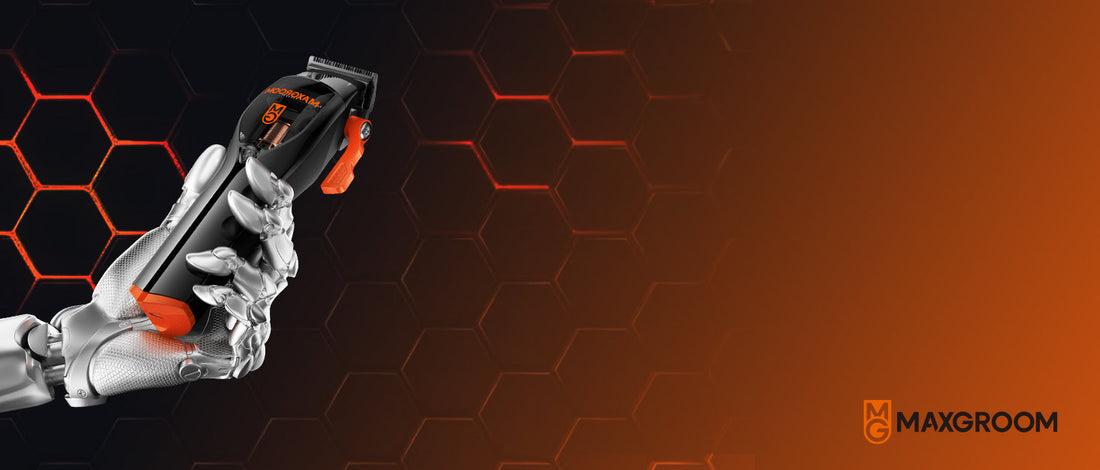From Structure to Performance: A Deep Dive into the Core Technologies Behind a Professional Hair Clipper

For professional barbers, hair clippers are not just tools—they are precision instruments. This article offers a comprehensive breakdown of a professional-grade clipper, from internal structure and motor performance to blade configuration, guide comb systems, ergonomics, and maintenance best practices.
1. The Anatomy of a Professional Clipper

A well-designed professional clipper typically consists of the following core components:
-
Blade Assembly: Comprising a moving and a fixed blade, this part determines cutting accuracy and efficiency.
-
Motor: The power source driving the blade movement—central to the clipper’s performance.
-
Taper Lever: Allows fine adjustment of blade length—essential for fading and tapering.
-
Guide Combs: Control cutting length and layering during gradual blending.
-
Power System: Determines portability, runtime, and consistency (cordless or corded).
-
Housing & Ergonomics: Affect comfort, control, and fatigue during extended use.
2. The Motor: The Engine Behind the Performance
The motor is what separates a clipper that glides through hair from one that struggles and pulls. Here’s a comparison of the most common types:
| Motor Type | Key Features | Best For |
|---|---|---|
| Brushed Motor | Affordable, simple, but loud, less durable, and inconsistent torque | Entry-level or backup tools |
| Brushless Motor | High RPM (6000–7500), stable power output, quieter, longer lifespan | Professional daily use |
| Magnetic Levitation Motor | Ultra-fast, ultra-quiet, delivers crisp line work—ideal for detailing | High-end detailing & fades |
Why RPM (Revolutions Per Minute) Matters:
RPM directly impacts:
-
Cutting speed and smoothness
-
Ability to handle dense, coarse, or curly hair
-
Fade and taper smoothness
Benchmark RPM ranges:
-
5000–6000 RPM: Suitable for regular trims
-
6500–7200 RPM: Ideal for thick or coarse hair
-
8000+ RPM: For high-detail fades, skin lines, and sharp contours
3. Blade System: The Core of “Effortless Cutting”

Blade Materials:
| Material | Features | Ideal For |
|---|---|---|
| Stainless Steel | Affordable, durable, reliable | General use |
| Ceramic | Low heat, quiet operation, but fragile | Long working sessions |
| Titanium / DLC | High hardness, low friction, ultra-sharp, corrosion-resistant | Precision cuts on coarse hair |
Zero-Gap Adjustment:
-
Enables ultra-close cutting for skin fades and line detailing
-
Requires high-precision blades and a stable motor
-
Must be calibrated properly to avoid skin irritation or cuts
4. Guide Combs: The Hidden Heroes of Layer Control
| Length Range | Application |
|---|---|
| 1.5–4.5 mm | Base fades, skin fades |
| 6–13 mm | Mid blending zones |
| 16–25 mm | Top length management, longer layers |
High-Quality Comb Features:
-
Magnetic attachment for fast, secure swapping
-
Rounded teeth for smoother gliding and better comfort
-
Numbered system for consistent results

5. Taper Lever: The Key to Seamless Blending
-
Standard taper levers offer adjustments in 0.5–2 mm range
-
Allow precise mid-fade or drop-fade transitions
-
Look for tight, click-based control or adjustable tension screws on pro models
A well-tuned taper lever gives you much greater control when fading and transitioning between clipper lengths.
6. Hair Texture Matching: There’s No One-Clipper-Fits-All
| Hair Type | Recommended Setup |
|---|---|
| Coarse / Curly | High-torque motor + wide-tooth titanium blade + firm comb system |
| Fine / Soft | Rounded ceramic blade + quiet motor + lightweight body |
| Buzz Cuts / Bald | Zero-gapped blade + 6000+ RPM motor + close-cutting fixed blade |
Different clipper specs perform better with different hair textures. Professional-grade tools allow customization for your clientele.
7. Ergonomics & Handling: Built for the Professional's Workflow

-
Balanced weight distribution reduces wrist strain
-
Anti-slip grip textures improve control during wet or long sessions
-
Low vibration design enhances accuracy and comfort
-
Noise levels ideally under 60 dB for client comfort
8. Maintenance & Durability: Your Clipper’s Longevity Plan
| Task | Recommended Frequency |
|---|---|
| Blade cleaning | After each use |
| Blade oiling | Every 2–3 clients |
| Deep cleaning | Once per week |
| Blade sharpening/replacement | Every 2–3 months or when dull |
| Battery care | Avoid overcharging or full drain |
📌 Tip: Use a dedicated blade spray and lightweight clipper oil to maintain smooth operation.
9. Common Pro Questions
Q: Why does my new clipper feel weak or dull out of the box?
A: Some clippers ship with the blades slightly off-gap for safety. You may need to adjust for true zero-gap or break in the blades.
Q: Are magnetic guide combs worth the price?
A: Yes—more secure, faster to swap, and more accurate than plastic snap-on combs.
Q: How do I evaluate if a motor is strong enough?
A: Look for stable output above 6000 RPM, minimal vibration, and no stalling under load.
10. Final Thoughts: The Right Clipper Makes the Cut
A professional-grade clipper is an investment in your skillset. When chosen correctly, it increases efficiency, improves cut quality, and elevates your client's experience.
Key takeaways:
✅ Stable motor output
✅ Precision-adjustable blade system
✅ Versatile guide combs
✅ Ergonomic, fatigue-resistant design
✅ Adaptability across hair types
✅ Easy maintenance for long-term use
No comments


0 comments